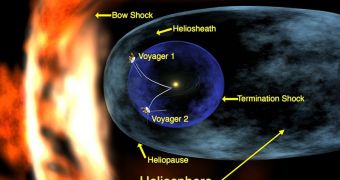Viewed as one of the most productive explorers ever launched by mankind, Voyager 2 was the probe that set, in 1989, the point where all the planets in the solar system had been visited at least once by a spacecraft. On its path across the solar system, the spacecraft Voyager 2 is now at a distance of 83.5 astronomical units, equivalent to double the distance between the Sun and the dwarf planet Pluto, but it has not passed yet beyond the orbit of the dwarf planet Eris. Computer simulations regarding the solar system show that Voyager 2 should cross a boundary named "termination shock" sometime in the late 2007, or the beginning of 2008.
The "termination shock" represents a spherical shell beyond the heliosphere, where the solar winds emitted by the Sun slow down their speeds to subsonic levels. This would allow the spacecraft Voyager 2 to measure the geomagnetic disturbances caused by the solar activities. Due to the fact that the time needed to cross the heliosphere limit is relatively short, scientists studying the problem are trying to extract the maximum amount of data out of this event.
Models of the solar system, based on the simulations made by Haruichi Washimi, a physicist at UC Riverside, suggest that the "termination shock" boundary is located somewhere at the distance of 90 astronomical units. It is created by the solar wind, which consists of streams of electrically charged subatomic particles, emitted by the Sun in all directions, at speeds exceeding the speed of sound, that will eventually hit and will be mostly absorbed by the interstellar matter.
The location of the boundary of the termination shock is not well defined, as the solar winds depend mostly on the solar activity. However, the scientists estimate it is set somewhere at a distance of 7-8.5 billion miles away from the Sun.
Also, the simulations show that the Voyager 2 spacecraft will finish the crossing of the termination shock in the middle of the next year, and will actually pass the boundary several time, as a result of the wobble of the boundary created by the Sun's activity, after which it will escape in the galactic space.
The spacecraft Voyager 2 was launched in August 1977 and was designed to visit the four gas giants and their moons while executing flyovers. Its twin, Voyager 1, had a faster trajectory that Voyager 2, and passed the termination shock in December 2004. The next boundary is the heliopause, where the solar wind is completely stopped by the interstellar medium. Although both of the vehicles are still operational, the degrading of their power sources and the failure of several instruments will probably cause both to shutdown by 2020 as they will not be able to power up any more instruments.

 14 DAY TRIAL //
14 DAY TRIAL //